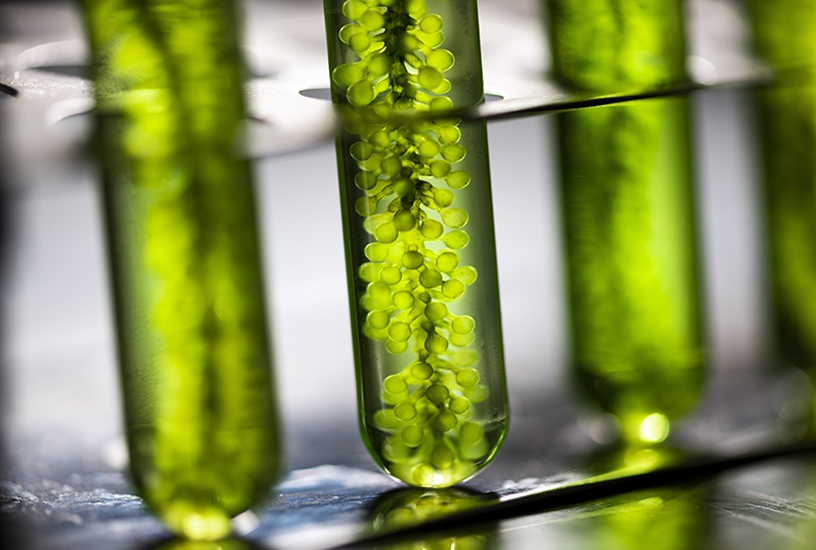Demonstrating Algal Phototaxis

AUSTRALIAN CURRICULUM ALIGNMENT
-
Cells require inputs of suitable forms of energy, including light energy or chemical energy in complex molecules, and matter, including gases, simple nutrients, ions, and removal of wastes, to survive (ACSBL044)
- Photosynthesis is a biochemical process that in plant cells occurs in the chloroplast and that uses light energy to synthesise organic compounds; the overall process can be represented as a balanced chemical equation (ACSBL052)
BACKGROUND
Phototaxis describes when cells or unicellular organisms move in response to light. Phototaxis can be demonstrated using Euglena, Chlamydomonas, or Volvox as a model organism. Phototactic responses have evolved in many Algae to aid in the process of photosynthesis. Algal cells can exhibit either a positive or negative phototactic response to light. In a positive response, the Algae will move toward the light, whereas a negative phototactic response is exhibited when the algal moves away to avoid light. However, in many cases, Algae will respond negatively to bright light and respond positively under dim light. Uniquely, Euglena exhibits a positive phototactic response in daylight, but remains unresponsive at night, regardless of a light source.
In this practical, students will observe phototaxis in action by undertaking two procedures that explore Algae phototaxis. The first procedure uses filtered light to illustrate how algae will move towards sources of light. In the second procedure students observe how Algae responds to light paths and varying degrees of light intensity. Both procedures are fun, interactive and can be conducted easily within the classroom, using inexpensive and easily accessible materials.
METHOD - STUDENT ACTIVITY
Procedure 1: Filtered Light
- Using scissors, cut narrow slits into a sheet black construction paper.
- Using sticky tape, secure the paper to the outside of the test tube.
- Add the Algae culture to the test tube.
- Store the tube in normal classroom light undisturbed for 10–15 minutes.
- Carefully remove the paper from the test tube, without moving the tube unnecessarily and observe changes to the Algae.
Procedure 2: Light Gradient
- Cover the outside of a petri dish with black paint, leaving only a horizontal slit on each of 2 opposing sides unpainted. Allow to dry.
- Position the painted dish on the stereomicroscope's stage, and prepare 2 microscope point lights (or penlights) to illuminate.
- Lower the room lights and add the Algae culture to the dish until approximately ¼ full.
- Reposition the point lights to focus on one point of light on the first slit and one on the other. Position one light close to the dish and the other a further distance of several centimetres. This will create a light gradient, whereby one side of the dish is subjected to high intensity light and the other is exposed to low intensity light.
- Observe the movement of the Algae under the microscope and see how it responds to the varying levels of light. Note any changes in the Algae's response as you intersect the light paths and alter the distance between the lights.
OBSERVATION AND RESULTS
Procedure 1: Filtered Light
-
Once the paper is removed, the Algae should be clustered where the light filtered through slits in the paper. This indicates positive phototaxis.
Procedure 2: Light Gradient
-
The Algae will respond negatively to bright light and respond positively under dim light. This indicates both negative and positive phototaxis.
EXTENSION EXERCISE
-
A great way to explore taxis further is to task students with culturing and growing slime mould (Physarum polycephalum) to study phototaxis and chemotaxis. Physarum polycephalum is a great model organism to study taxis due to its ability to respond to its environment. Test how this slime mould responds to varying levels and types of light, as well as its reaction to various chemicals and foods, such as fruit and cereal.
 Time Requirements
Time Requirements
- 55 mins
 Material List
Material List
-
Concentrated Algae (Euglena, Clamydomonas or Volvox)
- Test Tubes (Large)
- Black Construction Paper
- Scissors
- Clear tape
- Petri Dish
- Black paint
- Compound Microscope
- 2 Microscope Point Lights
 Safety Requirements
Safety Requirements
- Wear appropriate personal protective equipment (PPE).
- Know and follow all regulatory guidelines for the disposal of laboratory wastes.
- Wash hands thoroughly before and after handling any chemicals.
- Sterilise work surfaces before and after the practical.
- Dry plants and moist paper out entirely and place in a resealable bag to dispose of safely in municipal waste
